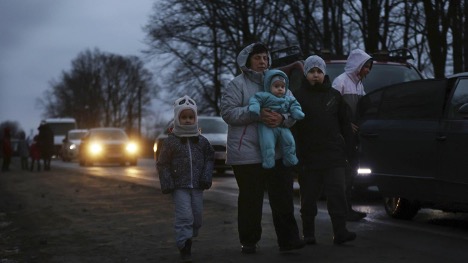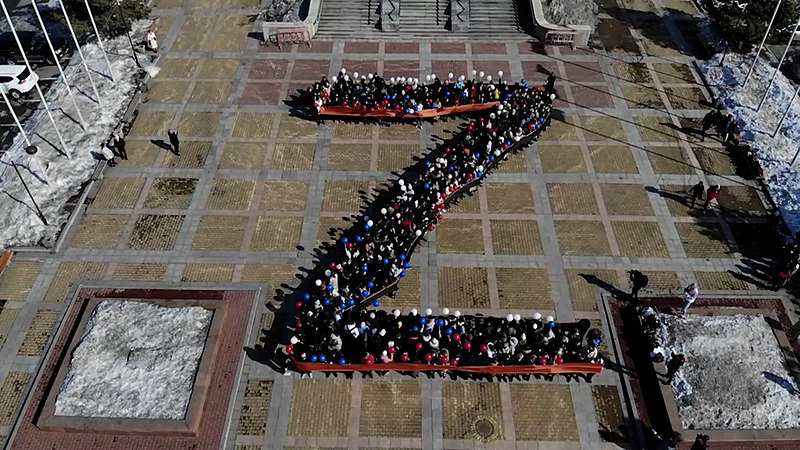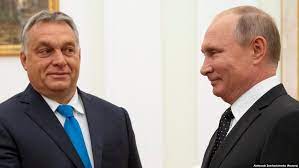
Ukrainian refugees and internally displaced people, almost all women, children, and elderly, now top 12 million
The Left has tangled itself in knots over how to respond to the Russian invasion of Ukraine. Early statements, such as by CodePink and Black Alliance for Peace, while putatively opposing war, laid emphasis on US and Western responsibility, NATO’s inexorable eastern expansion having “provoked” the attack; labeled the 2014 Maidan events as a “US-backed coup,” which had forced the Russian occupation of Crimea and its attempts to separate the eastern border region; and failed to condemn or even mention Russian President Vladimir Putin. Looser talk labeled Ukrainian nationalism as wholly fascist, and even all Ukrainians as implicit if not explicit Nazis, and charged that the Ukrainian government had been committing “genocide” against Russian speakers in the eastern part of the country. This position dovetails with Putin’s propaganda line justifying his war—as well as that of the right fringe of US Republicans, embodied by Tucker Carlson’s full-blooded support for Putin. Such expressions exhibit a disturbing tendency that Leila Al-Shami, already in 2018, called “ the ‘anti-imperialism’ of idiots,” in reference to knee-jerk Western leftist support for the brutal Assad regime in Syria (and, by extension, its just-as-brutal Russian patron). The operative principle seems to be that the enemy of my enemy is my friend.
As the horrors of the Russian attack have washed over us, the more extreme articulations of this position have become rarer—even Donald Trump forgot his initial adulatory praise of Putin—and most Left commentary now opposes the invasion. But there is still a strong tension between those who see the imperative of the moment as defending Ukraine and condemning Russian aggression and those who primarily blame NATO for creating the situation.
Key Points of Contention: Maidan, Azov, Minsk, and Western Hypocrisy
Those skeptical of diving into the tide sent forth by Western officialdom and the mainstream media full-fledgedly backing Ukrainian President Volodymyr Zelensky cite several issues: a dark underside of Maidan—a switch from nonviolence to armed confrontation, fomented by extremists; the prevalence of neo-Nazis in Ukrainian politics and military, exemplified by the Azov Battalion; the failure of the former president Petro Poroshenko and Zelensky governments to implement the Minsk agreements of September, 2014 and February, 2015; and, more broadly, the hypocrisy of the unambiguous Western embrace of white Ukrainians—both those suffering and dying from Russian attacks and the millions of refugees—as compared to the lack of such support for victims of aggression in Yemen, Syria, Afghanistan, and elsewhere in the Global South. The pro-Ukrainian Left counters with a more nuanced view of Ukraine and, on the last point, acknowledges the hypocrisy but nevertheless insists on solidarity as the priority.
The protest movement that began in Maidan (Independence) square—soon christened “Euromaidan”—in central Kyiv in November, 2013, and now also referred to as the “Revolution of Dignity,” was in immediate response to the decision of the Ukrainian government, under then-president Viktor Yanukovych, to withdraw from an association agreement with the European Union, a decision seen to represent a submission to Russian pressure (see my article in the June 2014 Public i). Repression by police was met with a full-fledged occupation; the situation escalated until over a hundred people, almost all protesters, were killed in late February, 2014, and Yanukovych subsequently fled to Russia and his government collapsed. The participation in the protests of far-right elements such as the Right Sector, and attempts by the US government to influence the subsequent transition in its own interest, later became clear; Noam Chomsky and others have also pointed to the austerity program the EU agreement would have forced on Ukraine, and its role in a project of neoliberal incorporation of the country. But the movement was in essence one for an open and empowered civil society against a sclerotic and corrupt oligarchic politics. The involvement of diverse, including unsavory, elements, and the support of “false friends” abroad, should not delegitimize it. An article by three black and brown US activists entitled “When Should We Stop Excusing the Russian Invasion?” argues that “the suggestion that [Maidan] was primarily driven by the machinations of the USA turns the Ukrainian people into simple puppets of outsiders.” We might even see this as an example of what Italian Marxist Antonio Gramsci called the “historic bloc,” a counter-hegemonic alliance of political movements with different ideologies.

Euromaidan protesters in central Kyiv in 2014.
There is undoubtably a strain of exclusionary hatred and violence in Ukrainian nationalism, historically (discussed below) and, though less so, today. But Putin’s narrative of waging a crusade against Nazism is as fake as his claims that Ukrainians are bombing their own civilians and actors are staging atrocities. Like in other East European countries where an imposed and mostly cynical Communist “internationalism” suppressed and distorted expressions of national identity for decades, post-communist liberalization—paired with neoliberal transformation—created a field ripe for right-wing nationalist extremism to flourish. (West European powers, especially France and Germany, not to mention the US, have themselves not been immune to this disease.) But although the far Right gained a few seats in the 2014 Ukrainian parliamentary elections, an electoral alliance failed to gain any in 2019, and its support nationwide has hovered around two percent or less. The Azov battalion has moderated its previous white supremacist orientation, and purged some of its extreme members; it is currently engaged in defending the country—heroically, it must be said—rather than in a racial crusade. The fact that the country in 2019 overwhelmingly elected a Russian-speaking Jewish president who had relatives murdered in the Holocaust, however much it is repeated in the Western media, still absolutely refutes Putin’s charges.
Continued influence by the far Right in the Ukrainian government is cited to fault the Ukrainian side in the failed Minsk diplomatic effort. But the accords, hastily drawn up and often contradictory, and signed at a vulnerable moment for Ukraine, are, in the view of experts like British scholar Duncan Allen, “incompatible . . with Ukraine’s existence as a sovereign country.” Zelensky was elected with a mandate to seek peace in the ongoing war in Donbas, but it was not primarily the extremists who derailed the effort: skepticism over Russia’s good faith in allowing free and fair referenda in the east and respecting the results is widely shared among non-ethnically exclusive “nationalist civil society” across Ukraine. Russia’s continued fomenting of “frozen conflicts” in Transnistria (Moldova) and Abkhazia and South Ossetia (Georgia), in addition to those in Crimea and Donbas, validates this mistrust.
Almost no one on the pro-Ukrainian Left denies the hypocrisy of the West in its massive campaign against the bombings, brutalities, and suffering and to support war refugees, or the destruction and misery wrought across the globe by US imperialism. But, even after the end of the Cold War, it is not the only imperialism, and the current Russian one is no less brutal for being less extensive and powerful. In a February 25 “letter to the Western Left from Kyiv,” socialist Taras Bilous states that a critique of liberal internationalism does not mean that we should support “spheres of influence” for other imperialisms. Volodymyr Artiukh decries “US-plaining”: reducing events in Ukraine and elsewhere in Eastern Europe to “reaction[s] to the activity of your own government and business elites.” According to longtime Left commentator on Eastern Europe John Feffer, outrage at Russia’s war must “augment, not supplant” outrage at governments such as Israel, Myanmar, and Saudi Arabia, not to mention the US.
History and Memory: World War II, Bandera, and Babyn Yar
The contradictions of the millennium-long relationship between Russians and Ukrainians certainly impact the current conflict, as Putin himself recognized in his July, 2021 essay on their “historical unity,” denying the latter the right to separate nationhood. I outlined some of this history in my 2014 article; the World War II period has now become the brightest flashpoint. After the June, 1941 Nazi invasion of the Soviet Union, Ukraine became the site of incredible violence, what Timothy Snyder has dubbed the “bloodlands.” Ukrainian nationalists sought to take the opportunity of the disappearance of Soviet rule to establish an independent state, but Adolf Hitler’s racial hierarchy deemed them Slavic untermenschen unfit for self-government. Pieces of Ukraine were given to Romania and the rest subject to direct occupation; nationalist leaders such as Stepan Bandera were arrested and sent to concentration camps.
Putin’s much-reported obsession with achieving something he can present as a victory at the celebrations of May 9, the anniversary of the end of what Russians still remember as the “Great Patriotic War,” makes clear how large that war looms in his current mission. In his and many other Russians’ minds, they are fighting the same fascism again today in Ukraine. Westerners cite the hundreds of monuments erected to Bandera and other World War II-era Nazi collaborators since 2014 as evidence of that thesis. Bandera and his movement did see the Nazis as liberators (from the Soviets’ violent suppression of Ukrainian culture and identity, especially the genocidal Holodomor, or terror-famine, of the early 1930s), were antisemitic, and responsible for pogroms against Jews initially. But their primary enemy was always Russia and Bolshevism; the Banderists later sheltered some Jews, and there were Jewish fighters within their ranks. This kind of messy heritage of nationalism is typical for many Eastern and East-Central European countries ground up between two oppressive systems; comparable monuments have been erected in large numbers in Romania, Hungary, Serbia, Croatia, and elsewhere, without calls for the invasion of those countries.

“Flash mob” organized by the ruling United Russia party forming the “Z” symbol of support for Russian troops at the Platinum Arena in the Russian far eastern city of Khabarovsk on March 11. Photo by City of Khabarovsk, used with Creative Commons Attribution 4.0 International (CC BY 4.0) License
Russian missile strikes at the beginning of March that damaged the memorial site of Babyn Yar on the outskirts of Kyiv (known more widely by its Russian name, Babi Yar), where the largest single massacre of Jews during the Holocaust took place, turned Russian allegations of a fascist enemy on their head. Matthew Stevenson asks the question “Is Putin Hitler?” in Counterpunch—his answer is mostly yes. Masha Gessen calls the “Z” sign, now plastered across Russia to indicate support for Russian troops, the “new swastika.” President Biden has declared Putin a war criminal, and, most recently, charged him with genocide. The contentious issue of whether these actions fit the legal definition of a term often bandied about in reference to the Myanmar Rohingya, the Uyghurs in China, and other victims in recent years is complicated, but in any case beclouds the Russian undertaking in Ukraine, which also appears to have brought significant instances of sexual violence, in addition to the extensive bombings of non-military infrastructure, shellings of refugees, and executions of civilians and other atrocities in the Kyiv suburb of Bucha and elsewhere.
Effects on Europe—and Russia
The count of Ukrainian refugees has now topped 5.7 million, dwarfing the estimated 1.3 million from the global South of the 2015 refugee “crisis” that greatly destabilized European politics. (Another 6.5 million are displaced within the country.) In contrast to the hostility that many faced in the previous wave, these mostly women and children have been welcomed with open arms, even and especially in Poland and Hungary, the highest-profile anti-immigrant voices in EU debates since 2015 (together with Romania and Slovakia, they have taken the lion’s share of the Ukrainian refugees in the EU; Hungary’s include a sizable number of ethnic Hungarians). But the longer the war continues, the more problematic their integration will inevitably become. Hungarian Prime Minister Viktor Orbán, notorious for his close ties to Putin, initially—and surprisingly—joined the EU solidarity bandwagon; but in the run-up to the April 4 national elections he hammered the unfounded charge that the wide opposition coalition arrayed against him would take the country into the war, and won another four years in power handily. Far-right candidate Marine Le Pen was less able to distract from her ties to, and financial support from, the Russian leader; but though she lost the French presidential election rather handily, as a New York Times opinion piece declared on its eve, she had “already won” in shifting the national discourse. While some see the potential failure of Putin’s Ukraine endeavor as a decisive blow against the extremist international he has been fomenting, the current EU “united front” is likely a temporary reprieve from destructive far-right politics.

Hungarian Prime Minister Orbán meeting with President Putin on February 1, just weeks before the invasion of Ukraine, to request an increase in Russian gas
The fate of Russia itself is less explored, either in the Western establishment or on the Left. Hopes that the seemingly insane gamble would lead to Putin’s downfall, with the harsh economic sanctions turning his key oligarchs or even the Russian people against him, run up against his iron control of the media and the repressive levers of the state. His dream of creating a happy “Russian world” (Russky mir), encompassing the millions of ethnic Russians “stranded” in other former Soviet republics as they became independent nations seems to have run aground quickly in Ukraine, as exemplified by one woman displaced from the eastern city of Luhansk already in 2014, and now quoted in the New Yorker: “I’m ethnically Russian, I speak Russian, and I hate Russians.” But the many brave Russian anti-war protesters who took to the streets in the days after the invasion have given up and/or left the country in the face of draconian police repression, joining with an exodus of cosmopolitan and civic-minded citizens taking with them any hope that a genuinely new Russia could emerge from within the old. A major motivation of Putin for the invasion has been postulated as destroying an example next door of vibrant, if flawed, democracy. An article in the New York Times proposed that Russia is moving from “authoritarianism,” with no citizen participation, to “totalitarianism,” with full compulsory mobilization. Though our previously simplistic understanding of Soviet totalitarianism has evolved, crediting citizens with a capacity to “read between the lines” and understand politics on multiple levels, the pull of nationalism in such a historical context, as in the example of China, should not be underestimated.
Military or Diplomatic Solution?
The logic of the positions on both sides, and the cautionary specter of “appeasement” (referring implicitly to Great Britain failing to stand up to Hitler in 1938) does not encourage hope for diplomacy: one does not negotiate with Nazis, nor with war criminals and perpetrators of genocide. But an all-out military solution seems neither possible nor advisable. Western aid to Ukraine has been heavily weighted toward weaponry, with billions appropriated just by the US Congress. This is a boon to the arms industry, both in the US and Europe, and the potential entry into NATO by Sweden and Finland and the push to increase military spending across NATO states can only diminish the chances of a “peace dividend,” when and if this war ends. Whatever happens on the battlefield as the Russians launch their renewed offensive in the east, Zelensky will likely have to accept a painful compromise, in terms of sovereignty and even national territory, which he will be hard-pressed to defend to a public now hardened in its anti-Russian opinion. Another victim of the war, and of both mainstream and Left analysis, is the agency of Ukrainians—and Russians—in the face of “two rival projects” on a “collision course.” Still, the one thing that should unite the Left is opposition to militarism and the promotion of stepped-up diplomatic efforts, sadly lacking at this point (and since 2014).
A Local Angle
On April 19, Black journalist and Master’s graduate in both Journalism and Russian, East European and Eurasian Studies Terrell Jermaine Starr, currently based in Ukraine, returned to campus for a visit. He has witnessed firsthand the unfortunate discrimination against African and other Black students vis-à-vis white Ukrainians by Ukrainian border guards in the initial mass scramble to flee. Yet he maintains 100 percent support for Ukraine in the conflict. After originally studying in Russia, he had relocated to Ukraine because he felt it was safer there for a Black person. He sees Putin’s anti-Ukrainian ideology as akin to Hitlerism—its dehumanization enabling the violence to civilians—and as of a piece with Russia’s oppression of its Muslim and other minorities, such as Crimean Tatars, who have been branded “Islamic terrorists” for years. He pointed out the preponderance of these peoples among the conscript troops sent to Ukraine (and the 1999–2000 devastation of Chechnya, from which many of these soldiers come, provided a template for today’s assaults). He perceives Putin’s chief ideologist Alexander Dugan as representing Russians afraid of losing the privileges of whiteness: Putinites are Trumpies, and Ukraine equals Critical Race Theory.
Stepping back further, a geopolitical Left analysis dispels the mainstream mirage of a liberal democratic Western order saving itself by rallying around Ukraine against global despotism. An important precursor to both Putin’s rise to power and the strengthening of nationalism in Ukraine in the last decade is the economic destruction wrought by the neoliberal project in Eastern Europe. In this both Ukrainians and Russians are victims of a certain kind of negative Western stereotype of East Europeans, nurtured throughout the Cold War but with far earlier roots. This encourages Western resistance to a just, negotiated solution, in favor of “fighting Russia to the last Ukrainian,” as Noam Chomsky recently put it. With the surprisingly strong Ukrainian performance on the battlefield, the US administration seems to now hope to diminish Russia’s military, and political, power vis-à-vis the West’s over the long term—potentially including direct NATO-Russia military conflict, which could ultimately turn nuclear. The Western Left can, and must, do better.

767 total views, 1 views today